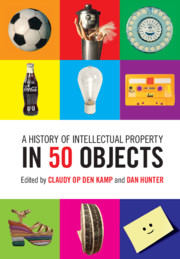Book contents
- Frontmatter
- Dedication
- Contents
- Acknowledgments
- Introduction: Of People, Places, and Parlance
- The Pre-Modern Period
- The Age of invention
- Modern Times
- The Consumption Age
- The Digital Now
- 39 Polymer Banknote
- 40 Post-it Note
- 41 Betamax
- 42 Escalator
- 43 3D Printer
- 44 CD
- 45 Internet
- 46 Wi-Fi Router
- 47 Viagra Pill
- 48 Qantas Skybed
- 49 Mike Tyson Tattoo
- 50 Bitcoin
- About The Contributors
40 - Post-it Note
from The Digital Now
Published online by Cambridge University Press: 12 June 2019
- Frontmatter
- Dedication
- Contents
- Acknowledgments
- Introduction: Of People, Places, and Parlance
- The Pre-Modern Period
- The Age of invention
- Modern Times
- The Consumption Age
- The Digital Now
- 39 Polymer Banknote
- 40 Post-it Note
- 41 Betamax
- 42 Escalator
- 43 3D Printer
- 44 CD
- 45 Internet
- 46 Wi-Fi Router
- 47 Viagra Pill
- 48 Qantas Skybed
- 49 Mike Tyson Tattoo
- 50 Bitcoin
- About The Contributors
Summary
THE POST-IT® NOTE is an excellent example of radical innovation that has achieved a nearly mythic stature in our consumer culture. Invented and manufactured by Minnesota Mining & Manufacturing Company, better known as 3M, the “Post-it” is a piece of stationery consisting of a small piece of paper with a re-adherable strip of adhesive on the back. It is designed for temporarily attaching notes to documents, computer displays, and so forth, and removing them without leaving marks or residue. The iconic Post-it note is a canary yellow three-inch Square pad, even though it also comes in various other sizes, colors, and styles. Emerging as a convenient medium for informal note taking, the Post-it sticky notes have revolutionized the practice. Their appeal is tremendous both in the office and in the home, as they are reliable and easy to use.
It is not surprising that the product and its success has found expression in populär culture, such as the 1997 film ROMY AND MICHELE's HIGH SCHOOL REUNION. Trying to reinvent themselves as successful businesswomen to impress their classmates, the title characters, played by Lisa Kudrow and Mira Sorvino, claim credit for the “Post-it,” “a product that everybody has heard about but nobody really knows who invented it.” In their imagination, the invention of the Post-it notes was a very simple process: they ran out of paper clips and stuck glue on the back of the paper.
In reality, however, the sticky notes did not always appear destined to set the office supply world alight. Unlike the common assumption linked to inventorship that there is a technical problem that needs solving, the discovery of the glue that is used in the Post-it notes was—according to its inventor—“a solution waiting for a problem to solve.”
The making of the repositionable note took around ten years from the discovery of the adhesive to its application. In the mid 1960s, 3M was carrying a four-year program on “Polymers for Adhesives” and one of their chemists, Spencer Silver, started performing experiments on a new family of polymers. Contrary to established scientific principles, which required mixing precise ratios of the various elements, Silver mixed an unusually large quantity of the element with the reaction mixture.
- Type
- Chapter
- Information
- A History of Intellectual Property in 50 Objects , pp. 328 - 335Publisher: Cambridge University PressPrint publication year: 2019
- 2
- Cited by

